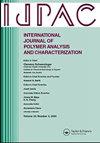A study on surfactant modified polypyrrole nanostructures and its applications in supercapacitors
IF 1.7
4区 工程技术
Q4 POLYMER SCIENCE
International Journal of Polymer Analysis and Characterization
Pub Date : 2023-08-18
DOI:10.1080/1023666X.2023.2267257
引用次数: 0
Abstract
Nanocomposites of Polypyrrole (Ppy), were synthesized by chemical oxidative polymerization of pyrrole, in the presence of mono and mixed‐surfactant solutions using ammonium persulfate as an oxidant and were investigated for its applications in super capacitors. The surfactants used in the experiments included anionic surfactants, sodium dodecyl sulfate (SDS) and sodium dodecylbenzenesulfonate (SDBS) and cationic surfactants, tetradecyltrimethylammonium bromide (TTAB) as well as cetyltrimethylammonium bromide (CTAB). The morphology and structure of the resulting Ppy were investigated in detail with FESEM and FTIR, respectively. The addition of anionic surfactants produced globular morphology. The results showed that the interaction between the different surfactants and the interaction between the surfactants and the polymer influenced the morphology, structure and conductivity of the resulting polymer to different degrees. Apart from these, XRD, UV-Vis spectroscopy and cyclic voltammetry (CV) were also performed to characterize the prepared composites. In comparison with the results for mono surfactant solutions, the polymerization of pyrrole in mixed‐surfactant solutions shows significant changes in morphologies and electrochemical properties of Ppy. The results of CV show that the specific capacitance values of Ppy samples with anionic surfactants are greater than cationic surfactants. In case of mixed surfactants, sample with SDBS + TTAB posses highest specific capacitance of 204 Fg−1 at scan rate 100 mVs−1. The good electrochemical properties can be attributed to the highly porous structural advantage of the Ppy sample prepared using SDBS + TTAB. It indicates the energy holding capacity or capacitance of the prepared samples and can be utilized in sensing applications like supercapacitors.
表面活性剂修饰聚吡咯纳米结构及其在超级电容器中的应用研究
以过硫酸铵为氧化剂,在单表面活性剂和混合表面活性剂的存在下,采用化学氧化聚合法制备了聚吡咯纳米复合材料,并对其在超级电容器中的应用进行了研究。实验中使用的表面活性剂有阴离子表面活性剂十二烷基硫酸钠(SDS)和十二烷基苯磺酸钠(SDBS),阳离子表面活性剂十四烷基三甲基溴化铵(TTAB)和十六烷基三甲基溴化铵(CTAB)。用FESEM和FTIR对所制Ppy的形貌和结构进行了详细的研究。阴离子表面活性剂的加入产生球状形态。结果表明,不同表面活性剂之间的相互作用以及表面活性剂与聚合物之间的相互作用对所得聚合物的形态、结构和电导率有不同程度的影响。此外,还利用XRD、UV-Vis光谱和循环伏安法(CV)对制备的复合材料进行了表征。与单表面活性剂溶液的结果相比,吡咯在混合表面活性剂溶液中的聚合表现出Ppy形貌和电化学性能的显著变化。CV结果表明,阴离子表面活性剂的Ppy样品比电容值大于阳离子表面活性剂。在混合表面活性剂的情况下,SDBS + TTAB样品在扫描速率为100 mv−1时具有最高的204 Fg−1比电容。采用SDBS + TTAB法制备的Ppy样品具有高度多孔性的结构优势,从而获得了良好的电化学性能。它表示所制备样品的能量保持容量或电容,可用于超级电容器等传感应用。
本文章由计算机程序翻译,如有差异,请以英文原文为准。
求助全文
约1分钟内获得全文
求助全文
来源期刊
CiteScore
3.50
自引率
5.30%
发文量
37
审稿时长
1.6 months
期刊介绍:
The scope of the journal is to publish original contributions and reviews on studies, methodologies, instrumentation, and applications involving the analysis and characterization of polymers and polymeric-based materials, including synthetic polymers, blends, composites, fibers, coatings, supramolecular structures, polysaccharides, and biopolymers. The Journal will accept papers and review articles on the following topics and research areas involving fundamental and applied studies of polymer analysis and characterization:
Characterization and analysis of new and existing polymers and polymeric-based materials.
Design and evaluation of analytical instrumentation and physical testing equipment.
Determination of molecular weight, size, conformation, branching, cross-linking, chemical structure, and sequence distribution.
Using separation, spectroscopic, and scattering techniques.
Surface characterization of polymeric materials.
Measurement of solution and bulk properties and behavior of polymers.
Studies involving structure-property-processing relationships, and polymer aging.
Analysis of oligomeric materials.
Analysis of polymer additives and decomposition products.

 求助内容:
求助内容: 应助结果提醒方式:
应助结果提醒方式:


